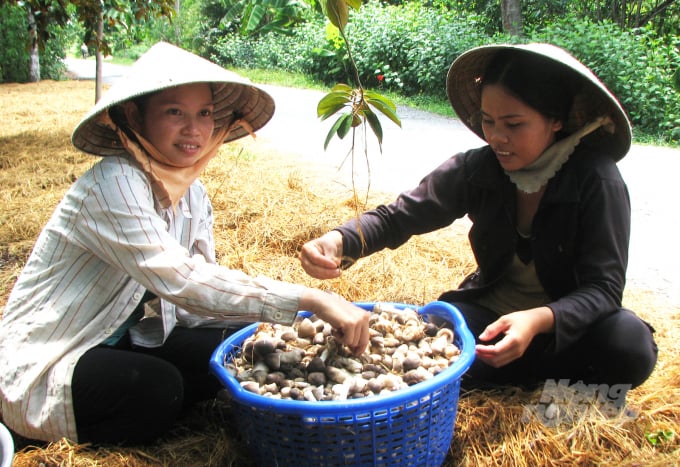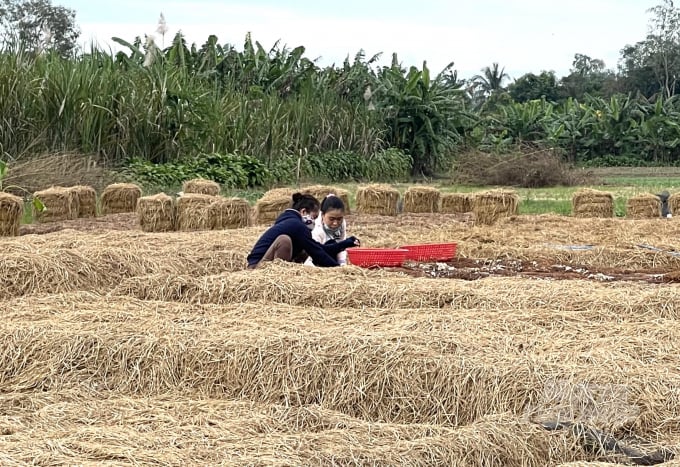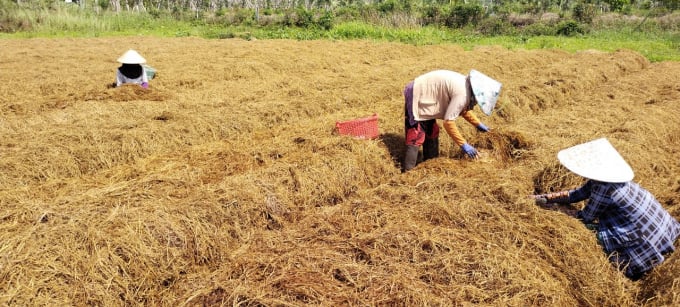June 20, 2025 | 12:08 GMT +7
June 20, 2025 | 12:08 GMT +7
Hotline: 0913.378.918
June 20, 2025 | 12:08 GMT +7
Hotline: 0913.378.918
Thanh Tri District in Soc Trang Province has an annual rice production area of over 55,000 hectares. After each rice crop, an abundant amount of straw is left behind. For a long time, farmers have been accustomed to growing straw mushrooms making it a quite popular movement.
With many ups and downs during the time after 2015, mushroom farming was neglected due to the application of mechanization in rice harvest that has hindered straw collection. But in recent years, mushroom farmers no longer face difficulty since a machine has been used for rolling straw making the farming gradually recover and thrive again.

By using straw by-products to grow mushrooms, farmers in Soc Trang have had an additional source of income. Photo: Huu Duc.
An official from the Agricultural Promotion Station in Thanh Tri District said the use of rice straw by-products after each crop is properly concerned by the people. Straw is not only used as food for livestock but also in growing vegetables and straw mushrooms to generate additional income. At the same time, the remains of rice straw after growing mushrooms can also be used to produce organic fertilizer for plants.
Moreover, straw mushrooms are fresh food rich in nutrients and with high effectiveness in disease prevention. Particularly in Soc Trang Province, favorable weather conditions and an abundant source of straw materials have helped develop mushroom farming since it can take advantage of leisure labor. Straw mushroom is a safe agricultural product contributing to poverty alleviation and straw mushroom farming can be developed into industrial production for both domestic consumption and exports.
Straw mushroom is a thermophilic species, so it is grown mainly in the hot and sunny season at a suitable temperature of 30-35 degrees Celsius and air humidity from 80%.
The straw that has been treated with lime is piled up. Farmers should choose a dry place to grow mushrooms without water submergence or flooding with enough light, unpolluted water, and air. They should also choose a place with lots of green trees, far away from sewerage, trenches, landfills, livestock barns or mushroom waste dumps. Prepare the soil carefully before stacking the mushroom tissue by lightly digging up the soil, spreading water and insecticides, creating drainage ditches on both sides of the mushroom, and filling the middle with soil.

Currently, Soc Trang Agricultural Extension Center is focusing on building and transferring models of growing straw mushrooms following a standardized process to ensure productivity and quality. Photo: Huu Duc.
Soc Trang Agricultural Promotion Center in collaboration with the district project team recently has organized a training course associated with building a demonstration model on using rice straw by-products to grow mushrooms" practiced by Mr. Danh Hoang's household in Trung Hoa hamlet, Tuan Tuc Commune, Thanh Tri District. The coursed was held in the autumn-winter crop 2020 within the framework of the Sustainable Agricultural Transformation (VnSAT) project in Soc Trang province,
Materials for planting on an area of 180 m2 are 150 straw rolls/150 bottles of meo. The average harvest yield will be about 1.5 - 1.7 kg of mushrooms/embryo bag and the output is 245 kg. The selling price ranges from 50,000 VND/k so the total income is over VND12 million.
After deducting all costs, farmers can make a profit of about 50%, equivalent to VND6 million/150 straw rolls. The model now is spreading since most of the neighbors near Mr. Danh Hoang's household have found its effectiveness. Mr. Danh Hoang said he will continue to maintain and expand the scale of growing straw mushrooms in the coming time.
Growing mushrooms outdoors proved to be effective. However, it is advisable to design a model of growing straw mushrooms in a closed house to overcome some limitations and adapt to climate change. This is really the right direction of development in the coming time.

Growing mushrooms outdoors proved to be effective. However, it is advisable to design a model of growing straw mushrooms in a closed house to overcome some limitations. Photo: LHV.
To replicate and sustainably develop the mushroom growing model, Soc Trang Agricultural Promotion Center recommends:
- The floor must be cemented to facilitate cleaning after each planting time. A multi-storey iron shelf or a pillar shelf should be designed to take advantage of the area,. The roof should be covered with corrugated iron or black silver sheet and the top can be arranged with a cooling spray system. The mushroom house needs to be covered around with rubber, installed with hung light bulbs and equipped with heating boilers. It should also be sterilized when the temperature is low and after each planting time.
- A standard model and growing process should be developed to propagate and mobilize farmers to change their perception of the new model through training and seminars on technology transfer.
- Growers should regularly observe each growth stage of mycelium to see if it is deficient of fertilizer, infected with wild fungus or develops unevenly so that to timely care and handle problems. Hygromete and thermometer should be used to check the environment.
- Let develop the concentrated mushroom growing to form a new commodity production and gradually develop large scale farms so that to actively contribute to the restructuring of the rural economy.
Translated by Linh Nguyen
![Turning wind and rain into action: [9] Digitizing hydrometeorological data in response to climate change](https://t.ex-cdn.com/nongnghiepmoitruong.vn/608w/files/news/2025/06/17/z6704423696987_15fd32ffc26d590d204d520c9dac6786-nongnghiep-165943.jpg)
(VAN) Farmers have begun accessing hydrometeorological applications to adjust their cropping schedules, aiming to ensure productivity and adapt to climate change.
![Turning wind and rain into action: [8] Real-time salinity detection and early warning technology](https://t.ex-cdn.com/nongnghiepmoitruong.vn/608w/files/news/2025/06/17/z6704423696987_15fd32ffc26d590d204d520c9dac6786-nongnghiep-151127.jpg)
(VAN) Thanks to the integration of modern hydrological-hydraulic models, remote sensing technologies, and artificial intelligence, the accuracy of hydrological forecasting has significantly improved.
![Turning wind and rain into action: [7] Early disaster warnings help marine farmers minimize losses](https://t.ex-cdn.com/nongnghiepmoitruong.vn/608w/files/news/2025/06/17/z6704423696987_15fd32ffc26d590d204d520c9dac6786-nongnghiep-142942.jpg)
(VAN) In recent years, thanks to early disaster warnings and forecasting, marine farmers in Khanh Hoa province have been able to reduce risks and losses, thereby improving production efficiency.
![Turning wind and rain into action: [6] ‘Four on-the-spot’ disaster management software](https://t.ex-cdn.com/nongnghiepmoitruong.vn/608w/files/news/2025/06/17/e5a48259d6a262fc3bb3-nongnghiep-183800.jpg)
(VAN) By simply activating the scenario on the disaster management software, the relevant authorities immediately know how many households need to be evacuated, where to evacuate them to, and by what means of transportation…
![Turning wind and rain into action: [5] Hue applies modern technology in disaster forecasting](https://t.ex-cdn.com/nongnghiepmoitruong.vn/608w/files/news/2025/06/17/z6704423696987_15fd32ffc26d590d204d520c9dac6786-nongnghiep-093938.jpg)
(VAN) In Hue city, modern technology has recently been applied in meteorological and hydrological forecasting and warning, helping to reduce the damage caused by natural disasters.

(VAN) A cutting-edge farming technique being implemented on an experimental ranch in Arizona's Sonoran Desert has already saved a billion gallons of water over five years, according to Civil Eats.

(VAN) Poultry and pig production and the environment can be boosted through enhanced water technology, according to new research.